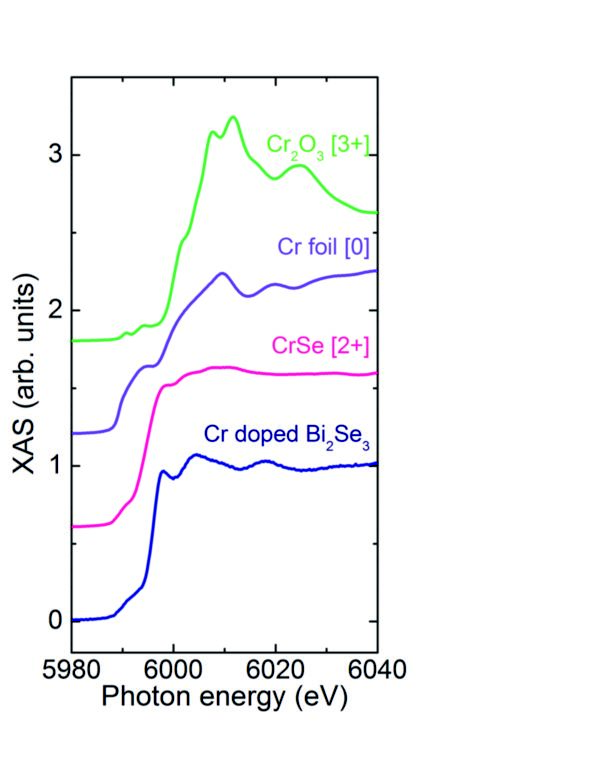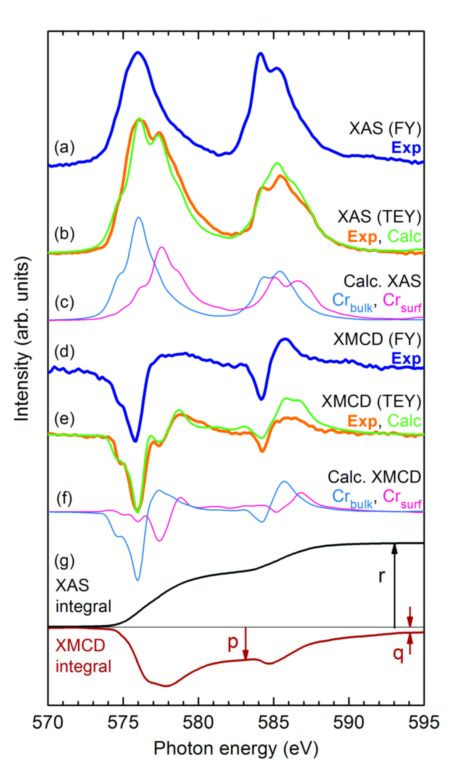 | ||
Are the Cr dopants in the Bi2Se3 topological insulator divalent or trivalent? |
Beamlines I10/B18 Scientific Highlight
X-ray Absorption Spectroscopy (XAS), Extended X-ray Absorption Fine Structure (EXAFS) and X-ray Magnetic Circular Dichroism (XMCD) were carried out on thin films of crystalline Bi2Se3 to determine local magnetic and electronic states. Data were collected on the Beamline for Advanced Dichroism Experiments – BLADE (I10) and the Core XAFS beamline (B18) at Diamond. Interestingly, results show that the dopant chromium (Cr) atoms are mostly divalent Cr(II), contrary to popular belief, which is attributed to the covalent character of the Cr- Se. Analysis suggests that the Cr atoms are in an octahedral environment rather than tetrahedral. The results from this study further the understanding of these unusual materials and should encourage a re-evaluation of the assumptions made about the oxidation state of transition metal dopants in topological insulators. In addition, they could lead to the initiation of calculations to better understand the covalent nature of magnetic dopants in TIs.
Magnetically doped topological insulators (TIs) have been the focus of many recent studies since they exhibit exotic quantum and magneto-electric effects, and offer the prospect of potential applications in spintronic devices. In these materials, ferromagnetic ordering leads to the breaking of time-reversal symmetry and the opening of a band gap at the Dirac point. These phenomena yield the observation of the quantum anomalous Hall effect, which has been experimentally demonstrated in Cr-doped (Bi,Sb)2Te3,1 and is predicted to exist in other Cr-doped dichalcogenides such as Bi2(Se,Te)3 as well. The choice of Cr as dopant for dichalcogenides over the more obvious transition metals manganese (Mn) and iron (Fe) is determined by the electronic structure. Whereas Mn and Fe lead to a quasimetallic state, Cr gives a ferromagnetic ground state in, e.g., Bi2Se3, as it is believed to be in a trivalent state that is isoelectronic to Bi3+.2

Figure 1: Crystal structure of Cr-doped Bi2Se3.
In the Bi2Se3 crystal structure (Fig. 1), quintuple layers (Se-Bi-Se-Bi-Se) are separated by a weakly bonding van der Waals gap. Cr dopants can enter into the lattice onto Bi sites or incorporate into the van der Waals gap, each site associated with a different valence state and site coordination of the Cr atoms. The established opinion in the literature is that the Cr dopant is trivalent because it substitutionally replaces the Bi3+ in Bi2Se3, similar to related compounds. This study used core-level X-ray spectroscopy techniques to selectively determine the local electronic and magnetic state of the Cr dopants in Bi2Se3 thin films. Contrary to the prevalent belief, substitutional Cr is found to be mainly divalent, which can be ascribed to the covalent character of the Cr–Se bonds.
XAS and EXAFS measurements of the epitaxially grown doped Bi2Se3 thin film at the Cr K edge on the B18 beamline demonstrated that Cr atoms are substitutional on the Bi sites, in which case the Se atoms are contracting locally towards the Cr compared to the original Bi–Se distance in the undoped compound. This contraction strengthens the hybridisation between the Cr and neighbouring Se. Comparison of the Cr K XAS with various relevant standard samples (Fig. 2) showed that the photon energy position of the absorption jump is close to that of CrSe, which has a valence of Cr2+.

- Figure 2: Cr K edge XAS of Cr-doped Bi<sub>2</sub>Se<sub>3</sub> thin film and comparison with CrSe, Cr<sub>2</sub>O<sub>3</sub>, and Cr foil for reference. The Cr oxidation state is indicated in the square brackets. Spectra have been vertically shifted for clarity.
XAS and XMCD at the Cr L2,3 edge, simultaneously measured in totalelectron yield (TEY) and fluorescence yield (FY) detection modes on I10 (BLADE), allowed us to determine the magnetic state of the Cr dopants in the Bi2Se3 thin film. Analysis of the FY and TEY spectra (Fig. 3) evidences Cr atoms which have different electronic and magnetic character at the surface than deeper in the film: XAS measured in TEY mode, which is more surface sensitive, shows Cr atoms with both 2+ and 3+ valence; FY XAS, which is more sensitive to the bulk, on the other hand, shows Cr dopants with mainly 2+ character. Sum rule analysis3,4 at the Cr L2,3 as measured in TEY, which relate the integrated intensities of the XAS and XMCD L2,3 spectra (Fig. 3) to the orbital (μL) and spin magnetic moments (μS), gives μS = (2.90 ± 0.3) μB/Crav. Fitting the XAS and XMCD of the bulk and surface contributions separately (Fig. 3), using multiplet calculations including charge transfer,5 gives spin moments of 3.64 μB/Crbulk and 1.91 μB/Crsurf, with an average spin moment of 2.84 μB/Crav, in good agreement with the sum rule result. Hence the moment of Crbulk is almost fully saturated.
The divalent character of the Cr dopants in Bi2Se3 thin films is ascribed to the hybridisation between the Cr d(eg) and Se p bands, which are located just above and below the Fermi level, respectively. This hybridisation gives the observed smoothening of the L2,3 multiplet structure (Fig. 3). The mixing between the electronic states is increased by the rearrangement of the Se neighbours around the Cr site, as evidenced by the EXAFS analysis. Since the electronic charge is redistributed within the Cr–Se bonds, it does not contribute to the concentration of free carriers.

Figure 3: Cr L2,3 XAS and XMCD of Cr-doped Bi2Se3 thin film. (a) Averaged XAS measured in FY;
(b) averaged XAS measured in TEY and comparison with the calculated spectrum; (c) separate
contributions of Crbulk and Crsurface to the calculated XAS; (d) XMCD spectrum measured in FY;
(e) experimental XMCD measured in TEY and comparison with the calculated spectrum; (f)
separate contributions of Crbulk and Crsurface to the calculated XMCD; (g) integrated intensities
of the summed XAS and XMCD measured in TEY. Values of p, q, and r used for the sum rules
analysis are indicated.
Source publication:
Figueroa, A. I., van der Laan, G., Collins-McIntyre, L. J., Zhang, S. L., Baker, A. A., Harrison, S. E., Schöenherr, P., Cibin, G. & Hesjedal, T. Magnetic Cr doping of Bi2Se3: Evidence for divalent Cr from x-ray spectroscopy. Physical Review B 90, 134402, doi:10.1103/ PhysRevB.90.134402 (2014).
References:
1. Chang, C.-Z. et al. Experimental Observation of the Quantum Anomalous Hall Effect in a Magnetic Topological Insulator. Science 340, 167-170, doi:10.1126/science.1234414 (2013).
2. Zhang, J.-M., Zhu, W., Zhang, Y., Xiao, D. & Yao, Y. Tailoring Magnetic Doping in the Topological Insulator Bi2Se3. Physical Review Letters 109, 266405, doi:10.1103/PhysRevLett.109.266405 (2012).
3. Thole, B. T., Carra, P., Sette, F. & van der Laan, G. X-ray circular dichroism as a probe of orbital magnetization. Physical Review Letters 68, 1943-1946, doi:10.1103/PhysRevLett.68.1943 (1992).
4. Carra, P., Thole, B. T., Altarelli, M. & Wang, X. D. X-ray circular dichroism and local magnetic fields. Physical Review Letters 70, 694-697, doi:10.1103/ PhysRevLett.70.694 (1993).
5. van der Laan, G. Hitchhiker's Guide to Multiplet Calculations. In Lecture Notes in Physics, Beaurepaire, E., Bulou, H., Scheurer, F. & Klapper, J-P. (eds), 697, pp. 143-200. Springer-Verlag: Berlin (2006).
Funding acknowledgements:
We thank Diamond Light Source for beamtime awarded on I10 (BLADE) and rapid access on B18. We also acknowledge the John Fell Oxford University Press (OUP) Research Fund.
Corresponding author:
Dr Adriana I. Figueroa, Diamond Light Source, adriana.figueroa-garcia@diamond.ac.uk


 A brighter light for science
A brighter light for science
